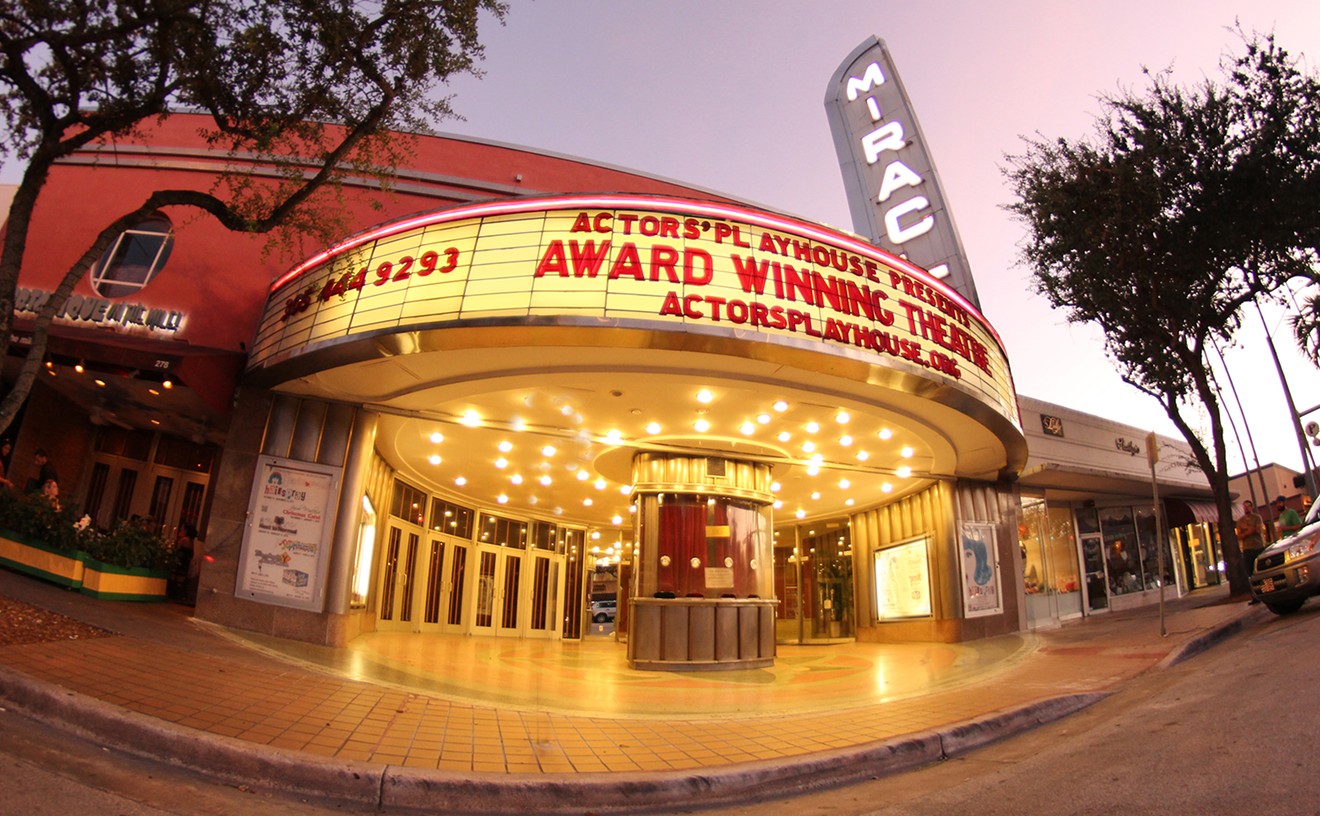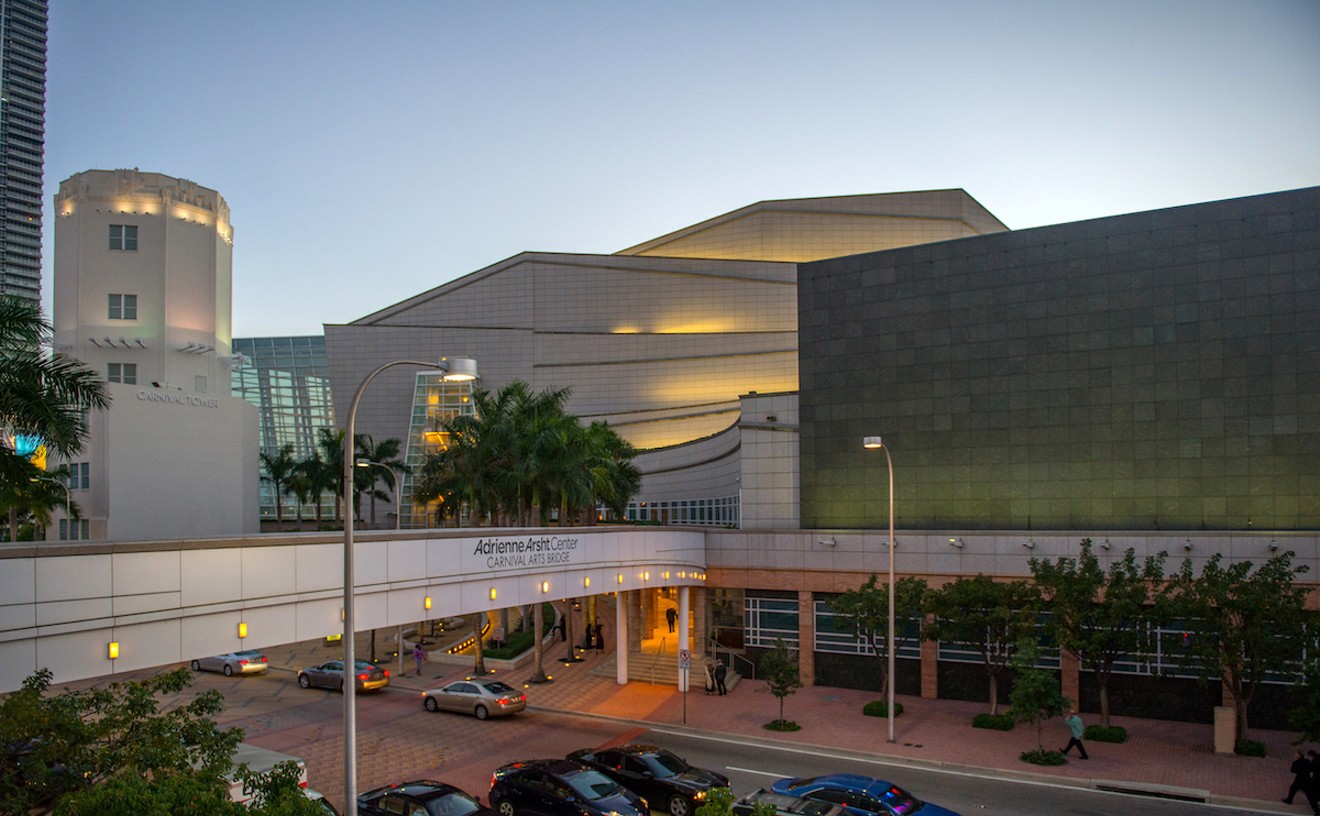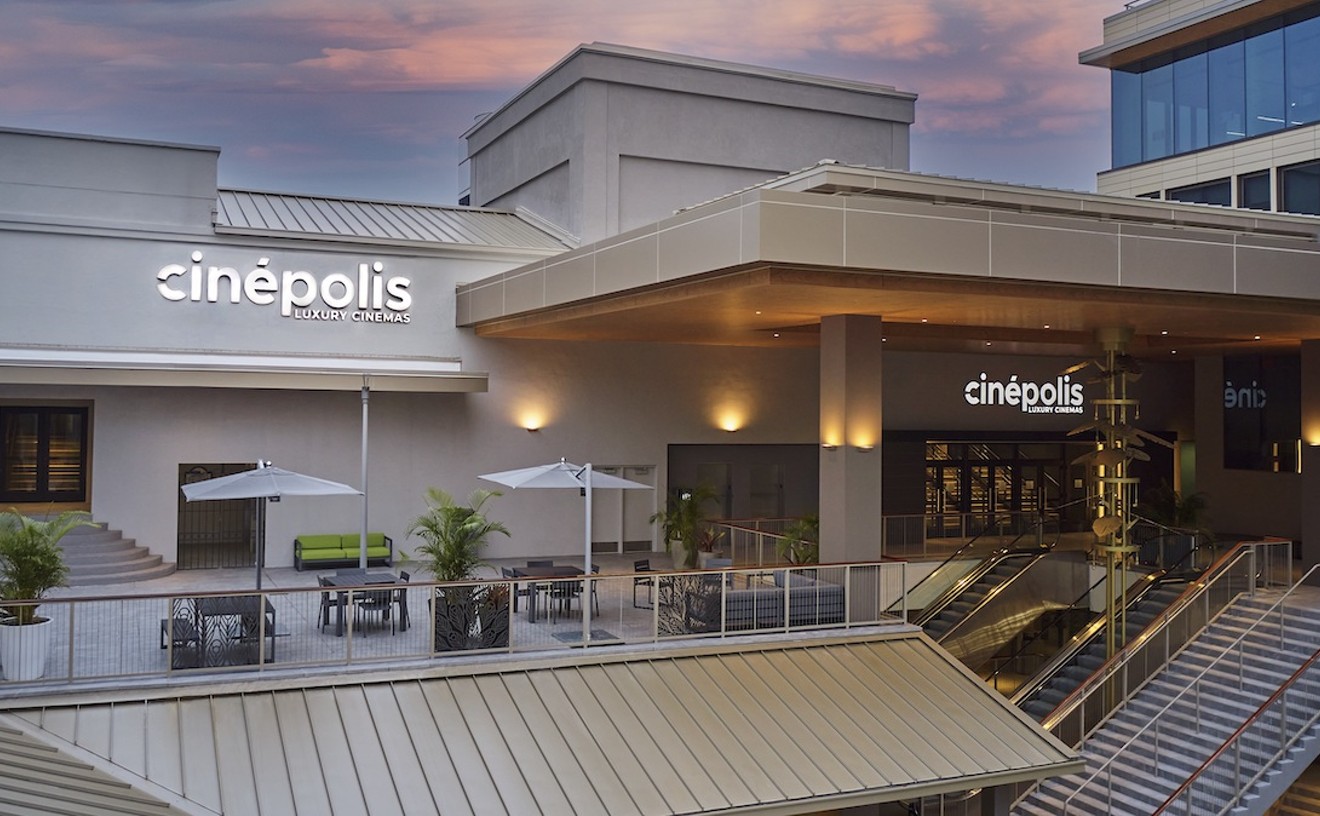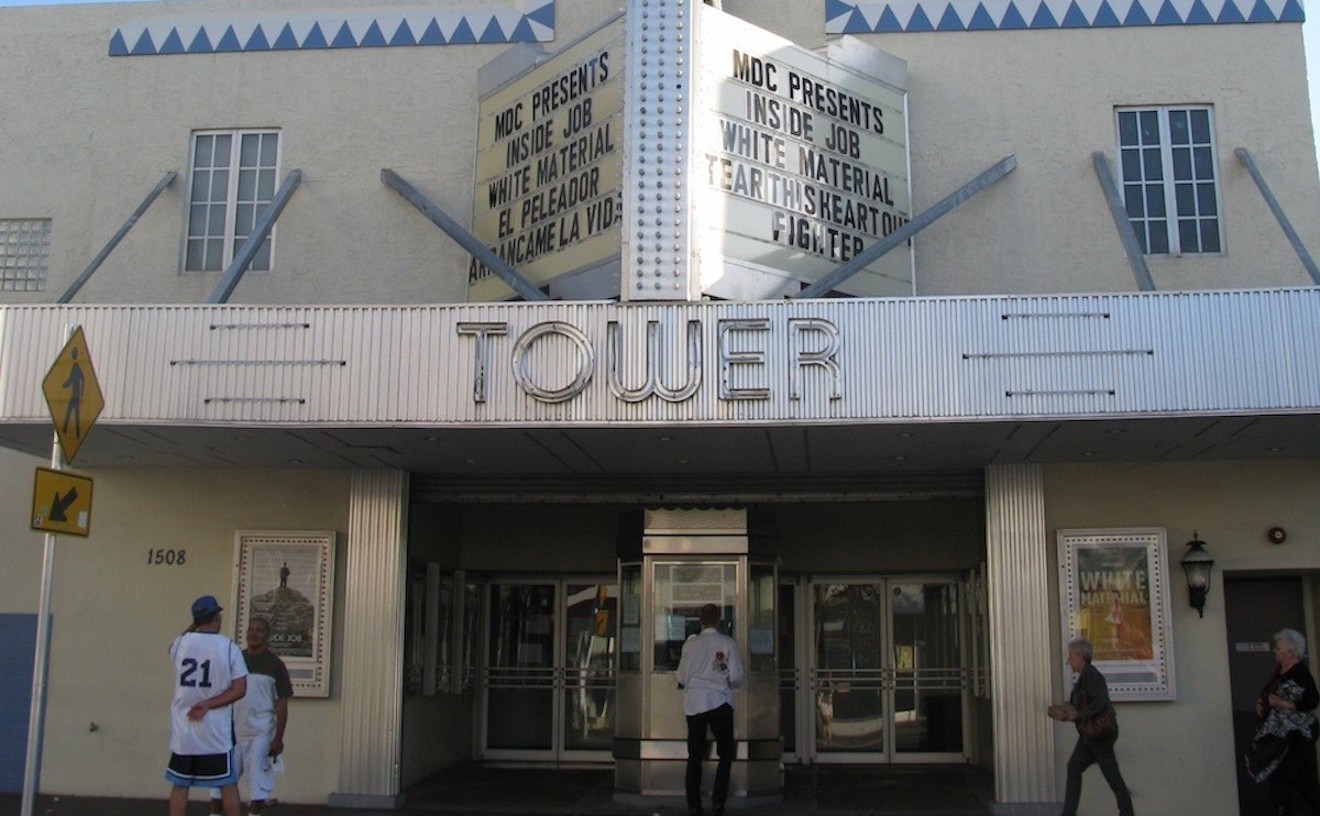Michael McKeever's set for Zoetic Stage's Assassins must have been a fun place to show up to work for its cast of ten. After all, it's not often you get to spend a couple of hours a night playing around and firing blanks into a multitiered carnival booth, not to mention exhaling your last breath while collapsing onto a flawless replica of the official presidential seal of the United States. With its mix of jingoistic colors and iconography and its peeling wooden marquee reading "Take Your Shot," McKeever's set resembled both Coney Island parlor games and White House pomp and circumstance — finding a visual representation of the nexus of the assassins' low-rent delusions and their unseen victims' patriotic grandeur. It was also a fount of hidden pleasures, from the centrally positioned, rotating presidential portrait to the red-and-blue police sirens tucked away in crates to the noose atop the stairway, which helped create one of the show's funniest visual gags. This might sound like a dubious honor for McKeever, but the fact is, if anyone had the choice to die on any set, it would be this one.
Best Set Design
Assassins
Best Play
End of the Rainbow

The Actors' Playhouse's End of the Rainbow was a funny and heartbreaking antidote to the stale formula of the Judy Garland musical revue. Moreover, it satisfied criteria for both best play and best musical of the year, encompassing the crackling dramatic exigencies of the former and the seemingly unpredictable cabaret atmosphere of the latter. Mostly, though, it was a bold look at faded glory — that of Garland, once the biggest star in the world, reduced at the end of her truncated life to insecure pill fiend, alcoholic, rotten friend, and erratic, occasional nightclub singer, when she wasn't too doped up to put one foot in front of the other. The perfectly diminutive Kathy St. George captured Garland's charms as well as her demons, and Colin McPhillamy exuded initial warmth and finally tragic pathos as her longtime pianist, a loving man ultimately crushed by the oblivious Garland steamroller. Director David Arisco handled the shifting genres with ease, especially the play's transitions from hotel room to nightclub — complete with a live onstage band — which never ceased to dazzle.
- 280 Miracle Mile, Coral Gables, 33134 Map
- 305-444-9293
- actorsplayhouse.org
Best Theater Company
Zoetic Stage

Zoetic Stage has been producing fine work since its inception in 2010, but this past season was the one in which the company really came into its own, establishing itself as a powerhouse incubator of new plays and an accomplished interpreter of canonical classics. The antiwar dramedy Fear Up Harsh opened the season with a proverbial mortar blast of energy, wit, and insight, earning a pair of Carbonell Awards in its wake, including Best New Work for playwright Christopher Demos-Brown. Its followup, Assassins, likewise plumbed comedy from dark scenarios. A standout cast, a spare-no-expense set design, and dynamite costumes brought to life the black humor, complex musicality, and blistering monologues of one of Stephen Sondheim's most controversial musicals. The season continued with one of Michael McKeever's finest comedies, Clark Gable Slept Here, a world-premiere satire about Hollywood that explored the movie industry's myth-making at the expense of its humanity — if such a thing can exist in the plastic Dream Factory. Producing only four shows in its season (The Great God Pan opened after this writing), compared with other companies' five or six, Zoetic had fewer chances to stumble, but the flawlessness of its track record remains impressive and sets an intimidating bar for next year.
- 1300 Biscayne Blvd., Miami, 33132 Map
- 305-949-6722
- arshtcenter.org
Best New Play
Fear Up Harsh

Few works, new or established, were as instantly visionary as Christopher Demos-Brown's Fear Up Harsh. The play, which premiered in an acclaimed production at Zoetic Stage, opened on a delirious gamble, in which the carnage of a war zone played in complete blackness, its actions bleeding into the next scene in a traumatic, time-shifting cacophony. The effect was dizzying and whiplash-inducing but never less than compelling, and it set the stage for a Brechtian exercise in the lingering effects of war (and awards) that deservedly won the Best New Work statuette at the 2013 Carbonell Awards. The hierarchies of rank, the politics of medals, the shameful horror of "enhanced interrogation techniques," and the struggles of being a single dad who is also a wheelchair-bound veteran coalesced into a 21st-century American tragedy that was also, when it wanted to be, one of the funniest plays of the year. Demos-Brown's knack for finding believably comic conversational nooks within a more damning, bigger picture cannot be understated; though, as he has said, some of the play's best lines developed from working out the production organically with his cast. Whatever the formula, it played out magnificently on the Arsht Center stage.
- 1300 Biscayne Blvd., Miami, 33132 Map
- 305-949-6722
- arshtcenter.org
Best Comedian
John Wynn

John Wynn grew up in Texas, where his brown skin and dark locks led many to mistake him for a Mexican. When he moved to Miami a few years ago, people suddenly decided he was Peruvian. He's actually Vietnamese, but lucky for us, all those years of racial profiling have provided him with a lifetime of laugh-out-loud situations to recount. In 2012, Wynn debuted his comedic web series, Labor Days, which features South Florida's most hilarious funnymen (Daniel Reskin, Lisa Carrao, Orlando Leyba, and others); its premise: Wynn (who plays himself) is mistaken for a Mexican day laborer in a Home Depot parking lot and, after losing his job, is desperate for below-minimum-wage work. In real life, Wynn was laid off as a professor just before his wife gave birth to his now-2-year-old daughter and currently teaches cinematography and editing as an adjunct professor at three schools. Season two of Labor Days is slated to air online in August. And when Wynn isn't shuffling between work and shows, you can find him pretty consistently on the first and third Tuesday of the month at Elwoods Gastro Pub downtown for comedy night.
- 188 NE 3rd Ave., Miami, 33132 Map
- 305-358-5222
- www.elwoodsgastropub.com
Best Drag Queen
Pussila

Pussila's trademark makeup paints a pretty good picture of her onstage personality. Her distinctive eye makeup resembles the wings of a demonic butterfly. It wouldn't look out of place at a Marilyn Manson concert. Her cherry painted lips, almost always arranged in a wide smile, tell a different story. In truth she's equal parts sweet and sour. Whether onstage as MC at Twist's stripper hut or roaming the bar at Mova, she's quick to deliver a cutting remark, but it's always delivered with a laugh and a grin. Her wardrobe can be equally sassy. Sometimes she'll don a bra fashioned into two tip cups. As we all know, a drag queen's bra can never be overstuffed, so don't be afraid to tip this Colombian-born drag veteran next time you see her out.
- 1057 Washington Ave., Miami Beach, 33139 Map
- 305-538-9478
- twistsobe.com
Best Party Venue
Ice Palace Film Studios

Since 1923, Ice Palace Film Studios has stood on the corner of North Miami Avenue and NW 14th Street, its white fortress-like walls surrounded by a manicured garden ideal for lounging. Given that unique vibe, it's no shock the space has served as everything from the home of Pulse Art Fair during the week of Art Basel Miami Beach to a makeshift nightclub for Deadmau5's free show and events during Winter Music Conference. Because the immense space is flexible enough to fit almost any kind of request, it's also used frequently for film production and commercial photo shoots. In fact, it features 85,000 square feet of interior space — including the West Building, the former home of Karu & Y — and 58,000 square feet of garden area. The stripped-down interior means it can be decorated in any fashion imaginable. In fact, the most impressive transformation occurred in 2008, when Stoli created a faux hotel where invited guests could sip free cocktails and enjoy an array of live performances and DJ sets. Booking Ice Palace costs most than renting a Hialeah banquet hall, but when you don't want your vision compromised and you need space for a couple thousand people, it's money well spent.
- 59 NW 14th St., Miami, 33136 Map
- 305-672-5117
- big-time.com
Best Movie Theater
Blue Starlite Mini Urban Drive-In

For film worshippers, movie theaters are the temple where an escape to a higher plane begins. Usually, it's the cinema that transports viewers to endless faraway realms, but what if the theater itself also did some of the heavy lifting? Thanks to one Austin, Texas man determined to revive a forgotten art in Miami, that's exactly what a new mini drive-in theater does. The Blue Starlite Mini Urban Drive-In, which opened in summer 2013, became a darling of the Wynwood neighborhood. Don't expect to drive up and see the latest blockbuster, though, because the Blue Starlite plays only movies of yesteryear — "indie films, art house, cult, Gen X/Y, childhood favorites, and drive-in classics," to be exact. Expect to see classic films such as Casablanca, The Blob, The Princess Bride, The Rocky Horror Picture Show, and perhaps the occasional movie released in the past decade. After only a few short months, the theater expanded to Virginia Key Beach, where moviegoers can enjoy classic flicks under the twinkling stars while cuddled up with their honeys on a sandy beach during fall and spring. And now the Blue Starlite has moved from Wynwood to a new location behind the Coconut Grove Playhouse, which is slated to open this July. The drive-in charges per car and per person in each car, but oftentimes you can get a deal for $30 that includes entry for one car slot, two people, and popcorn. Whether you go for the classic films or the outdoor ambiance, a trip to the drive-in is always a perfect way to spend a few hours away from the real world.
- 3015 Grand Ave., Miami, 33133 Map
- 305-446-6843
- cinepolisusa.com/our-locations/x0il8-cinepolis-coconut-grove
Best Art-House Cinema
Tower Theater

In August 2013, Calle Ocho's landmark movie theater closed for renovation. It finally reopened this past March, illuminating the neighborhood with its iconic marquee once again. Thank the cinematic gods! Because before the current art-house cinema craze, Tower was one of the first to bring foreign and independent cinema to the Magic City. It originally opened in 1926 as a state-of-the-art theater. In the '60s, it helped newly arrived Cuban refugees acclimate to American culture by screening English-language films with Spanish subtitles. Now, under the auspices of Miami Dade College, it continues to educate the public through a cultural exchange of thought and creativity on celluloid. You won't find any blockbusters here, but you have plenty of other options. Instead, for a $10 ticket you can watch some of the most underrated, obscure, and, yes, occasionally infuriatingly slow-paced works from across the globe. Unlike most of our local art-house theaters, Tower features two viewing rooms, for twice the cinematic fun. And along with Miami's other art-house film havens, it's proving that films can still entertain and move audiences without the help of IMAX screens and 3-D technology.
- 1508 SW Eighth St., Miami, 33135 Map
- 305-237-2463
- www.towertheatermiami.com
Best Movie Shot in Miami
Iron Man 3
Tony Stark had been rattled to his core. The brilliant inventor, playboy, and superhero was already suffering a righteous PTSD meltdown from the carnage that invading aliens had wrought on New York City, when a mysterious figure called the Mandarin began blowing up buildings left and right. So Stark — never lacking confidence — took to television to call out the mysterious figure, promise revenge, and even offer his home address. He didn't expect what came next: a full-out assault by armored helicopters that sent his high-tech home plunging into the ocean and nearly killed the guy everyone knows best as Iron Man. But Stark survived, and by following a series of clues, he pieced together the Mandarin's true identity and traced him to his secret lair. As Stark jetted across the water and swooped in for a final showdown, the camera zoomed in on the palatial retreat, and... wait a second. Is that Vizcaya? Yes, indeed. Miami residents could have saved the star of Iron Man 3, played by Robert Downey Jr., weeks of agony and billions in expense by pointing him toward the Mandarin's hideout, which — at least on film — is among the Magic City's most famed locales. But damned if it didn't make a great backdrop for a knockdown brawl between Stark and his nemesis, played by the legendary Ben Kingsley. Beyond all the onscreen glory, the blockbuster reportedly pumped $15 million in revenue into Miami's film industry during filming, with Vizcaya nabbing $100,000 in revenue and location fees. Any other cyborg heroes and villains want to come blow up the Magic City?





